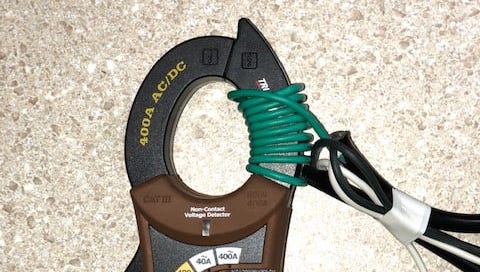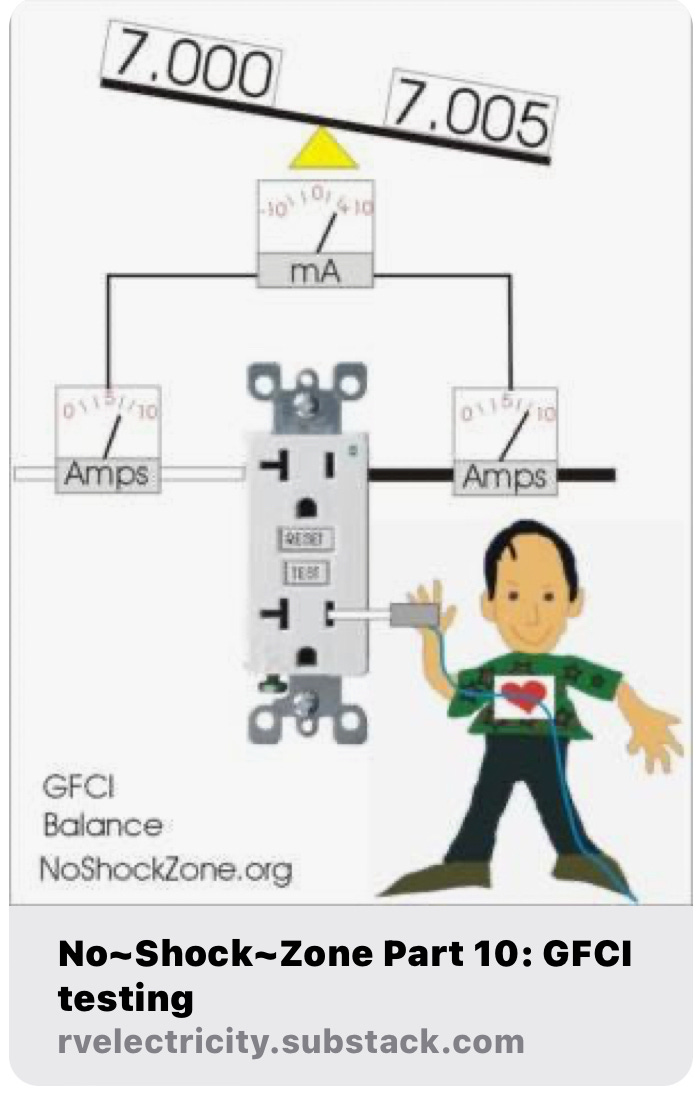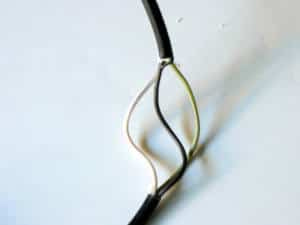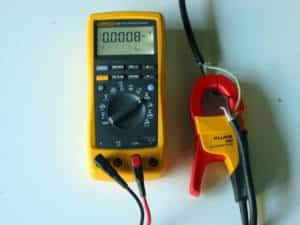A cheap trick for boosting clamp meter sensitivity!
From my in-depth article on GFCI leakage current testing. And it also works with DC clamp meters…
Everyone,
I’ve had a few questions about boosting clamp ammeter sensitivity by wrapping the test conductor around one of the jaws ten times. See below a subset of that article showing how this 10X wrap works. And yes, this trick also works with DC current as long as you have an AC/DC clamp meter.
You can also read my full GFCI theory and testing article HERE.
Measure it!
There is, however, an even better method for finding small AC leakage currents if you have a clamp-on ammeter such as the Fluke or Southwire testers shown in the pictures. To do this low-current testing properly you’ll need a meter that can display down to 0.001 amperes, which is 1 mA resolution. Clamp-on ammeters have a current transformer that looks for current flowing through the wires placed inside their jaws.
How clamp meters work…
However, if you simply clamp an ammeter around the entire power cord of an appliance, you’ll be summing the current going out from the black wire with the currents returning from the green and white wires and you won’t know the actual ground leakage current. Because the GFCI ignores the green wire current in its own leakage calculations, we need to do the same thing with our clamp-on ammeter to get the real current levels involved.
You can do this ground fault leakage test by sacrificing a short extension cord to make a test cable. (Don’t you feel like a scientist, now?)
With the extension cord unplugged from everything, just slit off the outer covering, being careful not to nick the insulation of the black, white or green wires. Get rid of any nylon filler and untwist the group of wires until you get something that looks like the picture to the right.
Keeping it safe
This is perfectly safe to use for testing, but because you’ve removed the outer protective layer of insulation, you’ll need to retire this particular extension cord from your regular hookup inventory. That why I typically do this modification to a short 6-ft. extension cord which I then keep on my test bench.
This modification allows you to plug your appliances one at a time into a non-GFCI outlet using your test cable to see how much current is leaking back to ground.
Clamp the ammeter around the black (hot) and white (neutral) wires as shown in the picture, keeping the green (ground) wire out of the jaws. or alternately, you can clamp the meter around the green ground wire. Either way will yield the same results.
What are you measuring?
Your ammeter will now be showing how much current is going out the black wire minus how much is coming back in the white wire. So any currents you read on the meter will be the ground leakage that can cause the GFCI to trip from that appliance. Or if you’ve clamped around the green ground wire you’ll be reading the amount of current leaking to the EGC ground wire, which will be the outgoing current minus the incoming current. Pretty neat!
Note that there’s going to be a certain amount of leakage to ground from anything plugged into a wall outlet. So less than 1 mA is not a problem. If you have a high resolution clamp meter like the one above one ($1,000+) you can read down to 0.1 mA of resolution, showing 0.0008 amps which is 0.8 mA of current flow, just less than 1 mA. That by itself shouldn’t cause a GFCI to trip. But you can see that if you have five appliances plugged into a single GFCI (like a campsite 20-amp receptacle) and each appliance is leaking around 1 mA of current to ground, and since 5 times 1 mA = 5 mA total leakage current, that GFCI breaker is going to trip whenever it feels like doing so.
A Cheap Fix!
Now, if you don’t have an expensive clamp ammeter that registers down to 0.1 mA of current, all is not lost. Most clamp meters under $100 will only register current down to 0.010 Amps which is 10 milliamps. To increase its resolution all you have to do is wrap the green wire in your test cord around the jaw of any clamp meter 10 times, and that will amplify the sensitivity of the meter by a factor of 10. So with a 10X wrap when your meter is reading 10 mA of current (0.01 amp) there’s actually only 1 mA (0.001 amp) of leakage current, and a reading of 30 mA (0.03 amp) on your clamp meter is actually only 3 mA (0.003 amp) of leakage current from your appliance, etc. Neat trick, eh?
Checking for AC leakage…
One way to check your entire RV for GFCI leakage current is to use a 15-amp dogbone adapter to plug it into this short test cord with all your RV circuit breakers and appliances off. Then turn on one circuit breaker and appliance at a time and monitor the amount of leakage current you’re seeing on the clamp meter. With the exception of the converter/inverter (which by code can leak up to 3 mA to ground and still be within limits), any other appliance in your RV which leaks over 1 mA of current to ground (reading 10 mA or 0.01 on your meter with the 10X modification) is suspect and should be evaluated for internal power supply ground–leakage problems and probably replaced.
Let’s play safe out there… Mike










I worked as a Technician for several years where I was repairing Appliances and Consumer Electronics back in 1979. I used the wire wrapping trick to measure small currents that wouldn't register on the clamp on meter that we had. Like you mentioned good ones are expensive and with a little ingenuity it is possible to get low current measurements this way.
Great trick Mike, thank you!